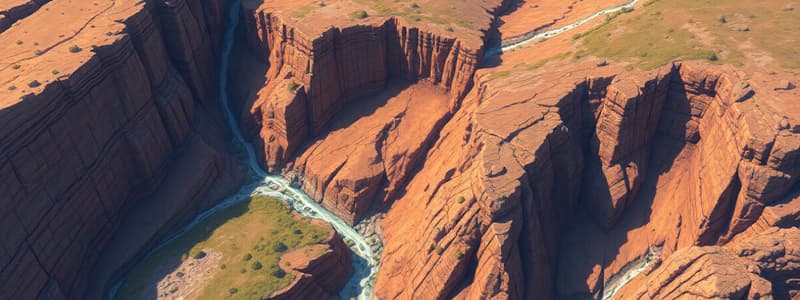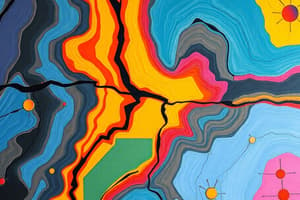Podcast
Questions and Answers
Which structural feature is typically associated with the hanging wall of a thrust fault?
Which structural feature is typically associated with the hanging wall of a thrust fault?
- Hanging wall anticline (correct)
- Fault tip
- Hanging wall syncline
- Footwall syncline
In what type of tectonic setting are accretionary prisms typically formed?
In what type of tectonic setting are accretionary prisms typically formed?
- Subduction zone (correct)
- Continental collision
- Inversion orogen
- Gravitational fold-thrust belt
Which type of fault is characterized by the shortening of rock layers?
Which type of fault is characterized by the shortening of rock layers?
- Normal fault
- Listric fault
- Strike-slip fault
- Thrust fault (correct)
What geological process primarily leads to the formation of extensional faults?
What geological process primarily leads to the formation of extensional faults?
What is a key characteristic of contractional tectonic settings?
What is a key characteristic of contractional tectonic settings?
What is the relationship between fold type and increasing displacement in fault-related folds?
What is the relationship between fold type and increasing displacement in fault-related folds?
In the context of thick-skinned fault and thrust belts (FTB), what is the importance of tracing horizons and identifying detachments?
In the context of thick-skinned fault and thrust belts (FTB), what is the importance of tracing horizons and identifying detachments?
In forward-propagating thrust systems, how does the age of thrusts relate to their position towards the foreland?
In forward-propagating thrust systems, how does the age of thrusts relate to their position towards the foreland?
What is the significance of 'growth strata' in the context of fault-related folds?
What is the significance of 'growth strata' in the context of fault-related folds?
What is a 'ramp' in the context of thrust faulting?
What is a 'ramp' in the context of thrust faulting?
What is meant by 'in-sequence' thrusting?
What is meant by 'in-sequence' thrusting?
What is the relationship between synkinematic strata and prekinematic strata according to the information provided?
What is the relationship between synkinematic strata and prekinematic strata according to the information provided?
What is a detachment fold?
What is a detachment fold?
Flashcards
Contractional Fault
Contractional Fault
A fault that forms due to the shortening of rock layers, causing duplication of units.
Extensional Fault
Extensional Fault
A fault that occurs when layers lengthen, leading to the loss of a part of the stratigraphic section.
Thrust Fault
Thrust Fault
A specific type of reverse fault where rock layers are pushed up over each other due to compression.
Subduction
Subduction
Signup and view all the flashcards
Fault-related Folding
Fault-related Folding
Signup and view all the flashcards
Detachment Fold
Detachment Fold
Signup and view all the flashcards
Flat and Ramp
Flat and Ramp
Signup and view all the flashcards
Growth Strata
Growth Strata
Signup and view all the flashcards
Forward-Propagating Thrusts
Forward-Propagating Thrusts
Signup and view all the flashcards
Subsurface Interpretation
Subsurface Interpretation
Signup and view all the flashcards
In-Sequence Thrusts
In-Sequence Thrusts
Signup and view all the flashcards
Tracing Horizons
Tracing Horizons
Signup and view all the flashcards
Study Notes
Thrust Tectonic Settings
- Contractional faults form due to shortening of rock layers, causing rock units to duplicate. These faults include reverse and thrust faults.
- Extensional faults form due to lengthening of a rock layer, resulting in a loss of stratigraphic section. Normal faults are an example of extensional faults.
- Thrust fault tectonic settings include subduction (accretionary prisms), continental collision, inversion orogens, and gravitational/deepwater fold-thrust belts.
- Thrust settings encompass thrust fault systems and thrust fault-related folding.
Contractional Structure Nomenclature
- Fault-related folds can be classified as hangingwall anticline (fault-related fold) and footwall syncline (fault-related fold).
- Thrust (flat) and thrust ramp (FW cut-off) are notable features.
- HW cut-off and FW cut-off identify different parts of fault-related folds.
Fault-Related Fold Types
- Fold type evolution is influenced by increasing displacement.
- Types of fault-related folds include transported fault-propagation folds, fault-propagation folds, and detachment folds.
Subduction Orogens
- Subduction orogens feature backarc regions, forearc regions, volcanic arcs, and forearc basins.
- These regions include trapped trench-slope accretionary prisms, forearc plutons, and areas where rising magma occurs.
Nankai Accretionary Prism, Japan
- The Nankai accretionary prism demonstrates imbricate thrust zones and megasplay fault zones.
- These zones sit atop the subducting sediment and trench fill.
Continental Collision
- Continental collision involves the merging of continents, forming a suture zone.
- Features include fold-thrust belts, internal exotic metamorphic zones, and remnant colliding continents.
Foreland Fold-Thrust Belts
- "Foreland" fold-thrust belt is a type of fold-thrust belt.
- The belt has a "foreland" basin, "internal zone", and "foreland" fold-thrust belt.
- These belts feature different zones of deformation, like lower-plate and upper-plate vergence.
Deepwater Fold-Thrust Belts
- Deepwater fold-thrust belts are geologic structures found in deep-sea environments.
- These belts contain different types of detachment, including shale and salt detachments.
Imbricate Fan, Offshore Namibia
- Imbricate fans are characteristic of thrust fault systems, seen in seismic images of offshore Namibia.
- Imbricate layers represent a stacking of fault blocks.
Two Types of Thrust Tectonics
- Thin-skinned tectonics and thick-skinned tectonics are two fundamental thrust tectonic types.
- Thin-skinned tectonics occurs along detachments, while thick-skinned tectonics involves deformation of the underlying basement.
Thin-Skinned Fold-Thrust Belts
- Thin-skinned fold-thrust belts are characterized by detachment within sedimentary layers.
- Examples include Ainsa Basin, Spanish Pyrenees.
Thick-Skinned FTB – Subsurface Interpretation
- Thick-skinned fold-thrust belts, shown through subsurface interpretation diagrams like those for the PDVSA area, exhibit different aspects of faulting and folding.
- Underlying caprock structures, geological formations and structures show important data related to the fault and fold systems.
Thrust Fundamentals
- Thrust faults typically involve duplication of strata.
- Issues/challenges in identifying thrust faults include complexities in hangingwall and footwall geometry; tracing horizons to separate the hangingwall vs.footwall; and identifying detachments.
Growth Strata
- Growth strata features postkinematic strata, prekinematic strata, and synkinematic strata.
- Growth strata can be recognised by fanning and by the development of structural styles.
Fault Styles
- Thrust faults, which involve the upward displacement of rock layers, are associated with different structural styles. Structural styles can include fault-propagation folds, fault-bend folds, and imbricate arrays/duplexes or passive-roof duplexes/active-roof duplexes.
Detachment Folding
- Detachment folding describes a structural process of folding in rock layers. It results in the formation of folded structures and associated geologic features.
Fault Propagation Folding
- Fault propagation folds develop at the tip of a blind thrust fault.
- Continued slip causes the fold to grow in proportion to the advancing fault ramp.
Fault-Bend Folding
- Fault-bend folds occur passively over time.
- Their development is dictated by the ramp and flats in a thrust system.
Imbricate Arrays
- Imbricate arrays consist of multiple thrusts, stacking to form thrust sheets along a surface.
Thrust Duplexes
- Thrust duplexes are formed by interconnected thrust faults and associated structures.
- Duplexes can be recognised through analysis of structures on seismic data and land-based exposures.
Exercises
- The provided pages include exercise questions related to these concepts in Thrust tectonics.
Studying That Suits You
Use AI to generate personalized quizzes and flashcards to suit your learning preferences.




